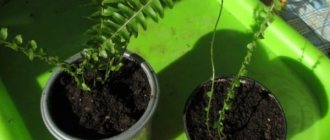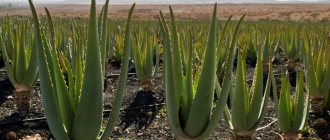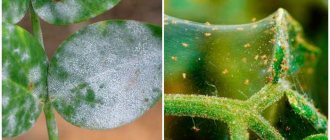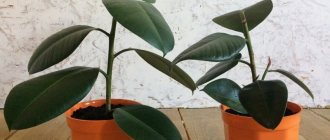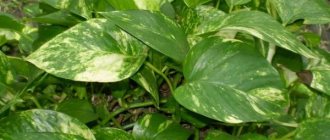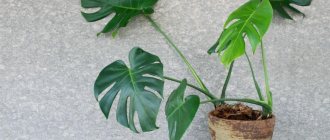Aloe is a perennial succulent from the Liliaceae family. It is native to desert and semi-desert regions of Africa, Madagascar and the Arabian Peninsula. The genus includes more than 20 species. Thanks to its fleshy and juicy leaves, aloe can retain moisture even during periods of severe drought.
A pot of aloe can be seen on many windowsills. This plant is grown not only for its decorative value, but also for its beneficial properties. As a rule, there are no difficulties in growing this succulent. It is easy to care for, but still needs a little attention.
Types and varieties of aloe for growing at home
Of the several hundred species of aloe, only a few of them are grown indoors.
Tree-like (aborescens)
The most popular type, which is also called agave. The trunk is fleshy, woody below. It bears pairs of gray-green leaves with spines along the edges. Can grow up to 1 m in height.
Faith (vera) or present
It is also called Indian aloe, Barbados aloe, Lanza. It grows in rosettes and has no trunk. The leaves are green, lanceolate, and may have white spots on the surface. There are pale pink spines along the edge. Blooms pale yellow. There are varieties with red flowers.
Jackson (jacksonii)
A bushy perennial with a short stem about 30 cm high. The leaves are narrow, up to 10 cm long. Small needles are located along the edge, and 1 longer thorn grows at the top. The surface of the leaves is covered with a waxy coating. A racemose inflorescence of tubular flowers of a reddish hue blooms on a long peduncle.
Camperi
A low-growing species with narrow, glossy, lanceolate-shaped leaves. They can reach 50 cm in length. They have small teeth along the edges. Flowers are formed on a high peduncle. Collected in racemose inflorescences of orange, red and yellow.
Short-leaved (brevifolia)
A perennial whose leaves are collected in a basal rosette. Their shape can be different, length is about 11 cm, color is bluish-green. There are white teeth on the edges and on the outside of the leaves. The flowers are tubular, red, bloom at the top of a long peduncle.
Soapy (saponaria) or spotted (maculata)
A bush with a branching stem on which leaf rosettes are formed. The shape of the leaves is flat-convex, length is about 60 cm. There are multiple white spots on both sides. The edge is strewn with spikes 0.5 cm long.
Spinous (aristata)
Bush-like succulent with short stems. The leaves are green, triangular, collected in rosettes, decorated with whitish tubercles. A long thread grows at the top of the leaf. The edges have spikes.
Tiger (variegata) or ausana (ausana)
A stemless shrub about 30 cm high. The leaves are elongated, 15 cm long, collected in a basal rosette. A pattern of white dots and stripes stands out against a dark green background.
Kinds
Bibliography:
- Cacti and succulents: Illustrated Encyclopedia / Anderson M. - M.: Niola 21st century, 2002, - 264 pp.: ill.
- Thorn: how to create a green oasis at home. Amazing cacti and succulents / Zhinel Leon. — M.: Eksmo, 2022.— 224 p.: ill.
- Cacti and other succulents: a reference book / D. Beffa. - M.: AST, 2002. - 256 p.: ill.
- Cacti and other succulents / Limarenko A.Yu., Paleeva T.V. — M.: ACT; St. Petersburg: Sova, 2005. - 96 p.: ill.
- Special issue of the newspaper “My Favorite Flowers” No. 11, 2013
- Agaves, aloe and other succulents / Udalova R.A. - St. Petersburg: Agropromizdat, 1994. - 112 p.: ill.
Home care
Aloe is not a capricious plant. But in order for it to develop normally and not be subject to diseases, it needs to be provided with suitable growing conditions.
Location and lighting
For aloe, it is very important that as much sunlight falls on it as possible. It can be placed on any windows except the north direction. If there is insufficient lighting, the succulent will have to provide additional lighting. But, despite the great love for the sun, in order to avoid burns, the plant must be shaded at midday.
You need to be especially careful with aloe in the spring. At this time, it comes out of the dormant period; a sharp excess of bright sun can be harmful. The succulent needs to be accustomed to it gradually.
Priming
The soil for aloe should be loose, well permeable to air and moisture. The pH level is neutral or slightly acidic. You can buy ready-made substrate for succulents or prepare it yourself.
Need to mix:
- leaf soil (1);
- turf (2);
- coarse sand (1).
For greater looseness, you can add a little charcoal or slightly acidic peat. Before use, the soil must be baked in the oven to disinfect.
Planting and transplanting
All types of aloe require regular replanting. The first time this should be done after purchasing the plant, if it grew in transport soil. Aloe roots grow very quickly. Therefore, until the age of 5, it must be replanted annually in the spring. Mature specimens - once every 2-3 years.
Algorithm of actions:
- Prepare a pot 1/5 larger than the previous one.
- Lay a thick layer of drainage and pour some soil on it.
- Carefully remove the aloe from the pot along with the soil. Transfer it to a new pot and fill it with the remaining soil.
- Water the plant lightly, and after a few days moisten it more thoroughly.
Step-by-step video - instructions for transplanting aloe:
Temperature
Since this plant comes from the tropics, it absolutely does not tolerate cold. Therefore, to maintain life, it needs to be provided with the correct temperature conditions.
In summer, a temperature of +20..25°C is suitable for growing.
Starting from October and until the onset of spring, it must be lowered to +14..16°C. In such conditions, the plant will comfortably survive the dormant period. Warning! In no case should aloe be exposed to drafts; it is also important to avoid sudden changes in temperature.
Air humidity
Like all succulents, aloe is indifferent to air humidity. It can be high or low. But if the room is too hot, you can give the plant a shower with a spray bottle. It is important to avoid water getting inside the leaf rosette.
Feeding and fertilizers
During the growing season, aloe is fed once a month. Mineral fertilizers for succulents are suitable for it. In the fall, fertilizing is stopped and resumed only in the spring.
Watering
Aloe should be watered sparingly. Despite its tolerance to drought, you should not overdry the earthen ball. In summer, the plant is watered on average 2 times a week. In winter, 1-2 irrigations per month are sufficient. It is important not to allow water to stagnate. This can destroy the culture. The water should be warm (+18..22°C). It must be left to stand before use. To improve photosynthesis, it is recommended to regularly remove dust and dirt from the leaves. A damp cloth or non-abrasive sponge is suitable for these purposes.
Bloom
In its natural environment, aloe blooms annually, sometimes twice a year. In indoor specimens, this phenomenon is quite rare; it can occur once every 10 years.
A long peduncle grows from the rosette, at the top of which a paniculate or spike-shaped inflorescence blooms. The flowers are small, tubular, and can be red, orange, pink, and rarely white. After flowering, the arrow must be removed.
Trimming
When transplanting adult plants, it is recommended to trim the roots slightly. This promotes the growth of a powerful root system in the new soil. In order for aloe to grow upward, side shoots can be periodically removed.
Does it grow outside?
In some regions, this crop grows in open ground. This usually happens in the south of Russia. At the same time, Aloe can grow much larger than at home. Moreover, you can completely forget about the need to periodically replant the flower.
If you plan to plant Aloe outdoors, you must consider the following:
- The soil must be loose so that the root system can receive sufficient minerals and other nutrients.
- It is imperative to clear the space of weeds.
- The roots need to be dried for three days. Only after this is planting in open ground possible.
- The area where Aloe grows can be covered with roots. This will prevent weed growth.
- The bait is produced using fertilizers that are suitable for Aloe Vera.
Important. The plant does not tolerate cold weather. Therefore, in regions with frosty winters, the plant needs to be replanted and brought into the house. You can also create a greenhouse that protects the crop from hypothermia.
Reproduction methods
To get new plants, you can use different methods - propagation by seeds and vegetative propagation (by shoots or cuttings).
Seeds
This is one of the most time-consuming and labor-intensive methods of propagating aloe. But thanks to it you can get a lot of young succulents. The procedure is best carried out at the end of winter or early spring. Prepare a planting container and ensure good drainage. Fill with peat-sand mixture. Sow the seeds evenly. Spray the substrate with a spray bottle and cover the crops with film. Germinate aloe at a temperature of +20..22°C. Regularly ventilate the greenhouse and water the soil. When the seedlings are 1 month old, they are planted in separate pots. After 3 months, they are picked again, and then cared for like adult plants.
Side shoots
The procedure can be carried out throughout the growing season. Use a sharp knife to separate a side shoot from the base of the bush. Treat the cut areas with charcoal. Dry the shoot in a dark place for 2 days. Plant in damp sand for rooting. After the roots appear, transplant the plant into a separate pot with suitable soil. In exactly the same way, apical cuttings can be used for propagation.
Children
Over time, shoots with a developed root system form near the bush. During transplantation, they can be carefully separated and planted in individual containers.
How to fertilize aloe
Apply fertilizer every three weeks from spring to early fall. They promote good growth.
Photo: [email protected] / Depositphotos
Use regular succulent fertilizer. Add them only to moist soil. Do not fertilize for the first month and a half after transplanting.
If you plan to use the plant for medicinal purposes, it is better to refrain from feeding at all.
Features of seasonal care
In spring and summer, aloe grows actively. It needs to be provided with good lighting, moderate watering and regular fertilizing. Since autumn, all vital processes slow down, the plant needs a period of rest. This can only be achieved under cool conditions and sufficient lighting. It is necessary to gradually reduce the temperature to +12..15°C, and reduce watering to once a month. To extend daylight hours, turn on additional lighting. In such conditions, aloe should be kept until spring.
Brief description of cultivation
- Bloom . Aloe is grown as an ornamental foliage and medicinal plant.
- Illumination . Needs more bright sunlight. Sometimes in winter it is recommended to highlight the bush.
- Temperature regime . During the spring-summer period, the flower grows well at normal room temperature. In winter, the room should be no warmer than 14 degrees.
- Watering . During the growing season, the substrate in the pot is moistened immediately after its top layer dries. In the winter months, watering is carried out less frequently, or rather, two days after the surface of the soil mixture has dried. When watering, make sure that liquid does not get inside the leaf outlet.
- Air humidity . Aloe grows normally at air humidity typical for residential premises.
- Fertilizer . Fertilizing is carried out from the second half of spring to the first autumn weeks once every 4 weeks, for this purpose mineral fertilizers are used.
- Rest period . It begins in the second half and ends in mid-spring.
- Transplant . Bushes are replanted at the beginning of the growing season, young bushes are subjected to this procedure once every couple of years, and older ones - once every 4 years.
- Soil mixture . Leaf and turf soil, as well as sand (1:2:1).
- Reproduction . By root shoots and seed method.
- Harmful insects . Aphids, scale insects, mealybugs and spider mites.
- Diseases . A plant can only get sick if it is not cared for properly. Most often it suffers from rot, which appears from excessive watering.
- Properties . Some aloe species have healing properties. They have anti-inflammatory, immunostimulating, wound healing, antibacterial, regenerating and other properties.
How to grow aloe
Care errors and their elimination
Useful information for gardeners about common problems when growing aloe and how to eliminate them:
| Problem | Causes | Solution |
| Withering and fading of leaves | Excessive watering, unsuitable soil | Allow the top layer to dry between waterings, replant the plant in a substrate for succulents |
| Pulling out shoots | Poor lighting | Move the flowerpot to a brighter place; in short daylight hours, additionally use fluorescent lamps for illumination |
| Brown spots on leaves | Sunburn, lack of moisture | Ensure timely watering, shade from direct sun |
| Falling leaves | Watering with cold water | Water with soft water at room temperature |
History and geography of plants
The oldest mentions of aloe as a medicinal plant date back to the second millennium BC. The ancient Egyptians studied and successfully put into practice the beneficial properties of aloe .
Unfortunately, it is not known for certain which variety of plant they used: it is hardly possible to identify the variety from images on the walls of temples and tombs. From them it is only possible to say that it was one of the varieties of aloe.
However, if we take into account that in Africa, neighboring Africa, aloe vera (also called agave) grows in quite large quantities in the wild, it can be said with a high probability that Egyptian healers and priests studied and used agave , calling it a “plant , bestowing immortality."
Unlike the agave, which is endemic to African lands, other subspecies of aloe grow in other countries and territories where the climate is warm enough for succulents: Barbados (island), the Arabian Peninsula, Japanese Curacao, etc.
Diseases and pests, control methods
Even with its unpretentiousness, aloe can be affected by diseases and pests. More often, problems are associated with excess moisture in the soil. Because of this, root or dry rot appears. The leaves darken and become soft. If fungal infections of aloe are detected, it is necessary to dig up and inspect the roots. Remove all affected areas and replant the plant in fresh substrate.
Aloe pests:
- mealybug;
- scale insect;
- spider mite;
- thrips.
For minor lesions, you can treat the leaves with a soap solution or alcohol tincture of garlic. In serious cases, it is better to resort to systemic insecticides (Aktara, Karbofos).
Why aren't these the same thing?
Modern botany numbers just over five hundred varieties of aloe . One of them is the agave. The latter, along with other varieties, belongs to the genus of succulents, which essentially creates the preconditions for confusion, especially for amateur flower growers who are inexperienced in this matter.
Agave and aloe are not the same thing. Individually, each of these plants is unique in many respects.
It is possible to consider agave aloe only when we are talking about its species. In other cases, when the appearance of the plant, its chemical composition, and medicinal properties are considered, it must be called agave, but not as a general name for aloe.
Aloe in the house: beneficial properties
Many people know the healing qualities of aloe. It is used for both medicinal and cosmetic purposes. For example, a mixture of agave juice and honey helps with coughs. To combat acne, crushed leaves of the plant are mixed with egg white and lemon juice. Taking aloe juice 15 minutes before meals in the morning and evening can help you fight excess weight. The juice also has moisturizing and regenerating properties. Therefore, it is often used in the composition of various cosmetic products.
When taking the plant internally, its contraindications must also be taken into account:
- liver and gallbladder diseases;
- haemorrhoids;
- pregnancy;
- children under 12 years old.
Aloe is a common succulent crop that is very popular for home growing. Caring for it will not be difficult even for a novice gardener. By paying very little attention to the plant, you can fully enjoy its decorative properties.
Video about varieties of aloe, planting rules, secrets of care and methods of propagation of the wonderful indoor aloe plant:
How did aloe and agave come to us from tropical countries?
To this day, heated discussions among scientists and specialists flare up around this issue. Accordingly, there is no consensus. According to the hypotheses put forward, aloe could have come to us from one of the three places presented below: South Africa, Madagascar or the Arabian Peninsula.
- At a time when these places were dying from the fiery heat, drought and lack of the slightest drop of water, all the plants withered and died. And only aloe was able not only to survive, but also to spread to other continents.
- The first mention of this plant and its unique medicinal properties was recorded in ancient Egyptian medical chronicles, which date back to about 1500 years ago. BC. This was done by a German scientist and writer named Georg Ebers, who at that time was studying the features of Ancient Egypt.
- Another interesting historical fact. Alexander the Great himself sought to conquer the island of Scrot (which he successfully achieved) for one main goal - to become the owner of a large number of aloe plantations in order to be able to use this miracle remedy in numerous campaigns.
There is also a slight difference in this matter between these types
- We will not touch upon each species with its history of origin separately, but tree aloe in the truest sense of the word takes its roots from South Africa. More precisely, from South Africa, Zimbabwe and Malawi.
- But real aloe comes from the Arabian Peninsula. It also grows widely in the Canary Islands and Sudan.
These succulents come from tropical countries with hot climates.
Contraindications
When used internally or externally, agave and other medicinal types of aloe have no special contraindications. However, in the case of using this plant as a laxative, it should be noted that taking it in high doses can disrupt intestinal motility, causing inflammatory processes in the large intestine.
For this reason, it is strongly recommended not to take drugs based on agave as a laxative for people suffering from uterine or hemorrhoidal bleeding. Another prerequisite for a contraindication to the use of the drug is pregnancy .
We invite you to watch a video about contraindications to the use of aloe:
